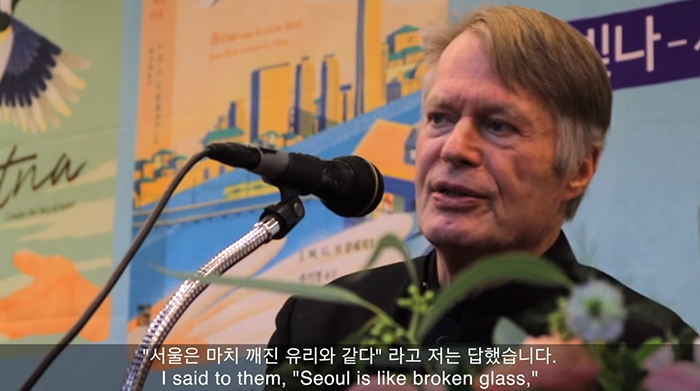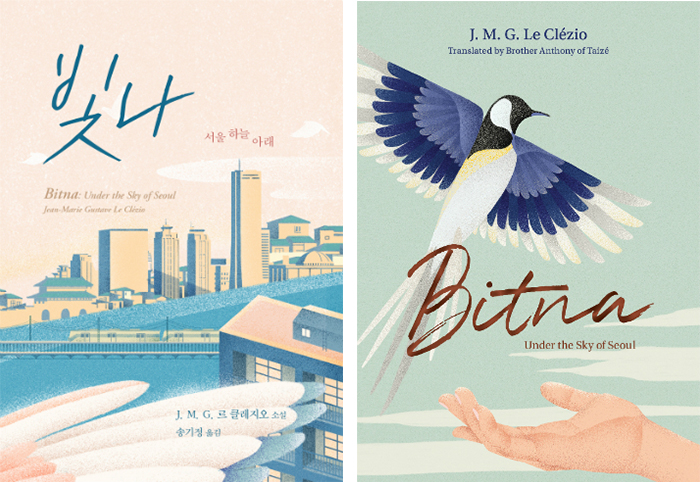
French author and Nobel laureate J. M. G. Le Clézio holds a press conference at the office of the publisher Seoul Selection in Jongno-gu District, Seoul, on Dec. 3, 2017. (YouTube)
By Yoon Sojung
What is Seoul like in the eyes of a French novelist and Nobel laureate?
The answer can be found in the novel “Bitna -- Under the Sky of Seoul” published in December last year by Nobel prize-winner Jean-Marie G. Le Clézio.
Le Clézio has been showing his affection for Korea by learning the Korean language just for himself. He has been repeatedly saying that he would write a story about Seoul someday, ever since his first visit to Korea in 2001.
Last October, the author wrote a novel inspired by a story titled “Tempête: deux novellas" ("Storm: Two Novellas") about the haenyeo women divers from Jeju Island. He even taught at Ewha Womans University at the Graduate School of Translation and Interpretation there as an honorary professor in 2007 and 2008.

The novel 'Bitna -- Under the Sky of Seoul,' written by French writer J. M. G. Le Clézio in December 2017, has been published in both Korean and English.
Le Clézio’s new novel centers around a 19-year-old young woman named Bitna.
Originally from a small fishing town in the Jeolla-do region, she moves to Seoul to begin university. Bitna begins a part-time job to tell stories to Kim Se-ri, a woman who rather hopes to be named “Salome” and who has been suffering from an incurable disease.
The five stories Bitna tells Salome include one about a man named Cho who left his home town in the north during the Korean War, one about an orphaned child named Naomi and the woman Hanna who looks after her, and one about a singer named Nabi who becomes a pop star but experiences hardships due to greed and untruth. All the characters created by Bitna touch upon various issues faced by Korean society, such as politics, history, religion, the generation gap, issues concerning the Korean Peninsula and other social issues.
These characters all seem to be individual and separate, but in some moments they become intertwined. Le Clézio sends a message of comfort and hope to readers while telling the stories to Salome as she faces death and Bitna who sees the intersection between life and death.
The name of the main character, Bitna, symbolizes the main message of the book.
During a press conference with journalists on Dec. 3 last year in Seoul, Le Clézio emphasized the meaning of the name Bitna.
“I like the name Bitna as bit means 'light' in Korean and the name is pure Korean,” the author told journalists.
“I want Bitna, a young woman, to represent courage and positive energy, as she brings light to a city like Seoul,” he said.
Le Clézio also said he traveled to many places in Seoul, not only well–known attractions like the royal palaces, the Hangang River or the Myeong-dong shopping district, but also lesser-known shabby and dark backstreets of the metropolitan city.
“Seoul is like broken glass, pieces of broken glass that shine individually rather than as a whole” he said.
“Seoul has been shattered by war and technological advances, but it has managed to cherish the beauty of its struggles,” said Le Clézio.
The press conference for author J. M. G. Le Clézio that was held at the Seoul Selection offices can be seen on YouTube at the link below. (source: Seoul Selection)
arete@korea.kr
Most popular
- 'We are back!' BTS Festa heralds hyped return of K-pop phenom
- K-pop streaming on Spotify skyrockets 470-fold in 10 years
- Hallyu gala MyK Festa from June 19 to feature K-pop acts
- President Lee starts G7 schedule via talks with S. Africa, Australia
- Korea Beauty Festival offers 'journey to find one's own beauty'
